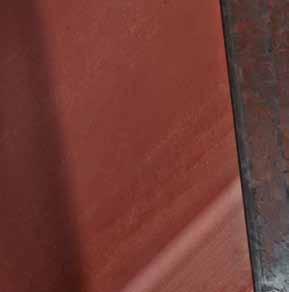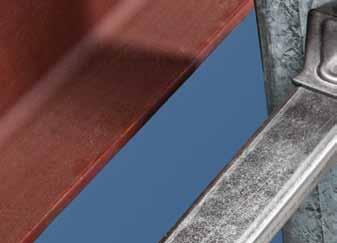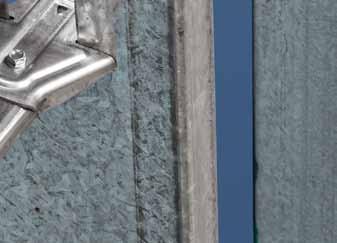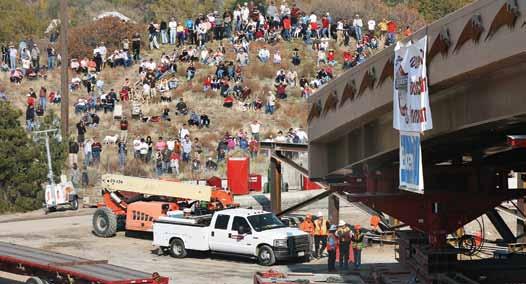
12 minute read
Construction Issues
discussion of construction issues and techniques A ccelerated bridge construction (ABC) technologies are changing the way transportation agencies do business, enabling them to replace bridges in hours instead of months, and significantly reducing overall delivery time. This timely innovation comes when many of the nation’s bridges need repair or replacement, and highways are already congested without the added strain of road closures, which can reduce infrastructure capacity. The Federal Highway Administration (FHWA) is working with states and industry to promote the increased use of ABC as part of its Every Day Counts initiative to accelerate project delivery, improve work zone safety, and minimize the impacts of transportation networks on the environment. ABC uses innovative planning, design, materials and construction methods in a safe, cost-effective way to improve on-site efficiencies when building new bridges, or replacing and rehabilitating existing bridges.
The use of prefabricated bridge Accelerated Bridge Construction elements and systems (PBES) is one strategy that can meet the Changing How America objectives of ABC. PBES are structural compoBuilds Infrastructure nents of bridges that are built off-site or near the existing structure, and include features that By The Federal Highway Administration’s Center for Accelerating Innovation and Office of Bridge Technology seek ways to reduce mobility impacts and on-site construction times. A prefabricated element is a single structural component of a bridge, such as a full-depth prefabricated deck, a modular deck beam, or a substructure unit. A prefabricated system is an entire superstructure, a superstructure and substructure, or a total bridge built in a modular manner. Prefabricated systems are rolled, launched, slid, lifted, or otherwise moved into For more information on FHWA’s place in a short time so that the bridge can be Every Day Counts initiative, visit opened to traffic quickly. www.fhwa.dot.gov/everydaycounts. To learn more about Highways for LIFE, see www.fhwa.dot.gov/hfl. For more information on ABC activities at FHWA, please contact Tim Cupples at timothy.cupples@dot.gov. With aging urban infrastructure and growing mobility needs, rapid renewal of transportation facilities is today’s mantra to minimize traffic congestion. Bridge replacement is often on the critical path of construction projects. Building in a more prefabricated manner using PBES can offer advantages over conventional bridge construction, including road user cost avoidance; reduction in work zone crashes; and, cost savings for traffic control, construction engineering and inspection, right-of-way acquisition and weatherrelated time delays. PBES can eliminate the need for temporary bridges and bypass approaches, often required to free up space at the construction site and accommodate through traffic. Temporary bridges are preferred over long detour routes, but construction costs, acquisition of right-of-way and additional environmental permitting can make that approach expensive. ABC also minimizes the need for staged construction, which may be necessary to accommodate through traffic and the contractor’s storage and staging area, and may incur additional costs for extra capacity, right-of-way acquisition and environmental permitting. Furthermore, staged construction often hampers productivity due to limited work areas and restricted work hours, and it frequently reduces traffic capacity during the construction phase. Implementing ABC technologies such as PBES may involve additional costs for items such as preliminary engineering, design and mobilization. But ABC’s shorter construction time produces savings through the reduction in traffic control, including items such as signage, barriers, pavement markings, traffic control devices, law enforcement and flaggers. Additionally, agencies may realize cost savings that result from the ability to move a project out of the planning phase
more quickly; ABC is better suited when it is necessary to address site constraints, and the public and private sectors’ need to maintain mobility. Data collected on FHWA Highways for LIFE demonstration projects showed that using ABC techniques cut on-site construction time an average of 67 percent compared to conventional methods. Road user costs on these projects dropped an average of 50 percent.
History of ABC and PBES
In the past, states that tried ABC technologies frequently did so on an as-needed basis, rather than in a more programmatic manner. Efforts to change the paradigm began in 1996 with a national initiative to encourage widespread use of innovations to accelerate construction of highway projects with longer service lives and lessen user delay and community disruption. A catalyst was publication of Transportation Research Board (TRB) Special Report 249, Building Momentum for Change, which called for creation of a strategic forum to promote accelerated construction of highway infrastructure. In 1999, TRB formed the Task Force on Accelerating Innovation in the Highway Industry (A5T60). Its objectives were to identify the barriers to innovation, advocate continuous quality improvement, encourage development of strategies that generate beneficial change, and create a framework for informed consideration of innovation. In 2000, the TRB task force hosted a Washington, DC workshop and shared its findings with FHWA and the newly formed American Association of State Highway and Transportation Officials (AASHTO) Technology Implementation Group (TIG). AASHTO created TIG to champion widespread implementation of ready-to-use technologies likely to yield significant benefits. In 2000, TIG chose PBES for nationwide implementation. In partnership with FHWA, a select number of Lead States championed PBES to other bridge owners and stakeholders across the country through tactics such as presentations, workshops, videos, and a website with PBES projects, publications and research information. Among many deployment activities, TRB A5T60, FHWA and AASHTO TIG began a series of Accelerated Construction Technology Transfer workshops in 2002 that included ABC techniques. When the PBES Lead States Team disbanded in 2004, AASHTO’s Subcommittee on Bridges and Structures Technical Committee for Construction took on the responsibilities of working with FHWA to continue
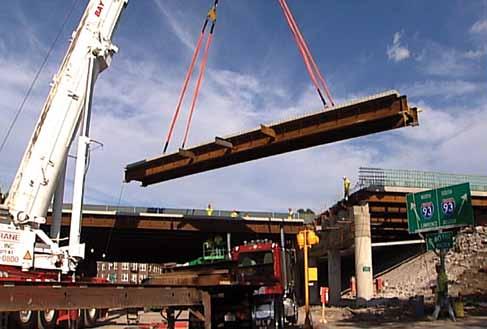
Workers used ABC techniques to replace 14 Massachusetts bridges in one summer while minimizing impact on drivers.
PBES/ABC implementation. FHWA and AASHTO also cosponsored an international scan on PBES (Prefabricated Bridge Elements and Systems in Japan and Europe, FHWA-PL-05-003, international.fhwa. dot.gov/prefab_bridges/pl05003.pdf). The scan team of bridge experts recommended implementation in the United States of several technologies, including full-depth prefabricated decks and movement systems using self-propelled modular transporters and lateral slides. In the years since the scan, team members have worked to implement these PBES technologies.
PBES in Practice
FHWA spearheaded an effort to address the national need for rapid innovation deployment through Highways for LIFE, a pilot program established by the United States Congress in 2005. It focuses on using sophisticated marketing approaches and dedicated teams to deploy innovations faster and more effectively. It also gives highway agencies incentives to use innovations and customer-focused performance goals to build highways and bridges better. PBES is one of the technologies Highways for LIFE chose for its Vanguard Technologies effort, which uses a model deployment process to mainstream innovations at highway agencies nationwide. Use of ABC and PBES resulted in reduced construction durations on several Highways for LIFE demonstration projects. An example is a 2007 project in which the Utah Department of Transportation (DOT) removed and replaced a bridge over Interstate 215 in Salt Lake City in one weekend. With the help of a Highways for LIFE grant, the agency tried – for the first time – self-propelled modular transporters (SPMT), computer-controlled vehicles that move heavy loads with precision. It used SPMTs to remove the old structure and move the new prebuilt one into place, cutting the mobility impacts from months to days. As a result of this experience and other projects that used ABC techniques, the Utah DOT made use of ABC technologies part of their standard practice in 2010. The trend grew to other state DOTs sent representatives to watch Utah’s bridge move. Highways for LIFE helped lay the groundwork for Every Day Counts (EDC), the initiative FHWA launched in 2009 to
The easiest to use software for calculating wind, seismic, snow and other loadings for IBC, ASCE7, and all state codes based on these codes ($195.00). Tilt-up Concrete Wall Panels ($95.00). Floor Vibration for Steel Beams and Joists ($100.00). Concrete beams with torsion ($45.00).
Demos at: www.struware.com
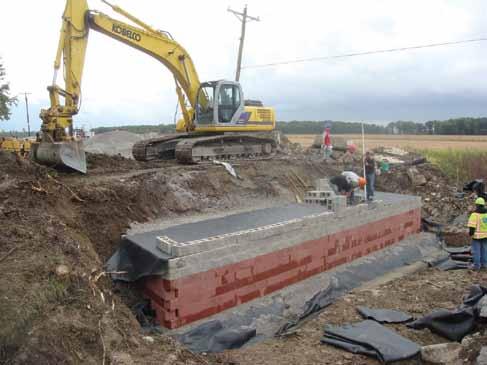
GRS-IBS technology, which uses layers of compacted granular fill and fabric sheets of geotextile reinforcement to provide bridge support, is part of FHWA’s Every Day Counts initiative to accelerate project delivery.
identify and deploy market-ready innovations aimed at speeding up project delivery, making roads safer and protecting the environment. EDC uses a state-based model in which FHWA Divisions, its frontline agents, work with state DOTs and other highway community stakeholders to make innovations standard practice. It focuses on high-priority initiatives to accelerate technology and innovation deployment, and get highway projects open to the public faster. From that menu of technologies, tactics, and techniques, each state chooses the options that work best for its highway program. FHWA teams work with the states to mainstream their selected initiatives and develop performance measures to gauge success. PBES earned a spot on the roster of the first round of EDC initiatives, introduced in 2010, and 46 state DOTs and Federal Lands Highway Divisions are now using PBES. Since October 2010, 887 bridges have been designed or constructed in an accelerated manner using PBES. In one example, the Massachusetts DOT used prefabricated bridge elements to replace 14 superstructures on I-93 in Medford, shrinking a four-year project to just one summer. The agency constructed the superstructures using modular decked beam elements that were built off-site, and installed them on weekends during 55-hour windows to minimize impact on travelers.
Expanding on Success
Building on the success of PBES in the first round of EDC, FHWA made ABC part of the second round of initiatives it announced in August 2012. This time, EDC is promoting two other ABC technologies in addition to PBES: slide-in bridge construction and the geosynthetic reinforced soil integrated bridge system (GRS–IBS). Over the next two years, FHWA’s EDC teams will work closely with transportation agencies and industry to deploy these solutions. Slide-in bridge construction is a costeffective technique for quickly replacing an existing bridge. A new bridge is built on temporary supports parallel to the old one. Once construction is complete, the road is closed and the existing bridge structure is demolished or slid out of the way. The new bridge is slid into place, tied in to the approaches and open to traffic within 48 to 72 hours. A number of states have constructed bridges using slide-in construction. GRS-IBS is a construction method that combines closely spaced geosynthetic reinforcement and granular soils in a new composite material. It is used to construct abutments and approach embankments that are less likely to settle and create a bump at the end of the bridge. The GRSIBS is easy to build and maintain, and 25 to 60 percent more cost-effective than conventional construction methods. So far, 74 GRS-IBS bridges have been built in 26 states, seven of which are part of the National Highway System. FHWA has developed various technical resources to help states use ABC, available at www.fhwa.dot.gov/bridge/abc. Among them is Accelerated Bridge Construction (FHWAHIF-12-013), which documents some of the current states of practice in using PBES for ABC. As a result of the increased awareness that EDC has created for PBES/ABC, state highway agencies are developing their own ABC websites, including the Massachusetts DOT (www.eot.state.ma.us/acceleratedbridges) and the Utah DOT (www.udot.utah.gov/ main/f?p=100:pg:0::::T,V:1991). The success of prefabrication is directly linked to the ability of industry to fabricate high-quality elements. The bridge industry has responded by investigating numerous materials and systems that can give design engineers the tools to design prefabricated bridges. Trade organizations such as the National Concrete Bridge Council, the National Steel Bridge Alliance, the Expanded Shale, Clay and Slate Institute, and the American Composites Manufacturers Association have provided the bridge community with technical assistance to ensure that prefabricated elements can meet accelerated construction needs and provide durable, long-lasting bridges.
The Future of ABC
The need to rebuild significant parts of the nation’s infrastructure has been well documented. Thousands of bridges need to be replaced, but the public prefers that those jobs be done with a minimum of traffic disruption – a feat that has been likened to changing the oil in a car with the motor running. Highway agencies and industry are looking to ABC as a viable way to respond to the challenge. ABC is a proven approach to reduce the mobility impacts arising from construction-related congestion on a typical bridge project, from years to weeks or even days. This greatly reduces the impact on the public and the economy. Surveys of highway users have documented an overwhelmingly positive response to ABC projects. These are the customers of the transportation industry, and their tax dollars pay for the system. More and more, highway agencies and industry are taking a businesslike approach to infrastructure reconstruction in which the customer is the focus of the project. ABC has given the highway community the ability to change fundamentally the way it builds – and rebuilds – the nation’s infrastructure.▪
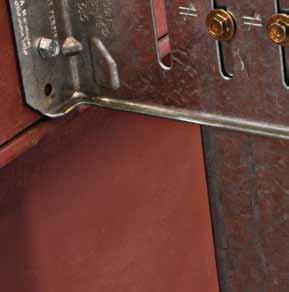


Fewer screws = lower installed cost



Our latest innovation for cold-formed steel construction is the new Simpson Strong-Tie® SUBH wall-stud bridging connector. It requires only one screw for most installations, reducing wall-stud bridging connector. It requires only one screw for most installations, reducing the installed cost over conventional clip-angle connections that require four screws. The the installed cost over conventional clip-angle connections that require four screws. The SUBH connector features a unique geometry that grabs the stud web and fi ts snug SUBH connector features a unique geometry that grabs the stud web and fi ts snug over 1.5" U-channel, enabling superior rotational and pull-through resistance. It over 1.5" U-channel, enabling superior rotational and pull-through resistance. It is self stabilizing and does not require an extra hand or C-clamps to hold the is self stabilizing and does not require an extra hand or C-clamps to hold the connector while a screw is being driven. The SUBH connector is the only connector while a screw is being driven. The SUBH connector is the only bridging connector/device that has been extensively tested as a system so that the tabulated design values refl ect stud web size and thickness. that the tabulated design values refl ect stud web size and thickness. The SUBH can be used with a wide range of stud sizes and gauges. The SUBH can be used with a wide range of stud sizes and gauges. Learn more by visiting www.strongtie.com/subh or calling (800) 999-5099.


